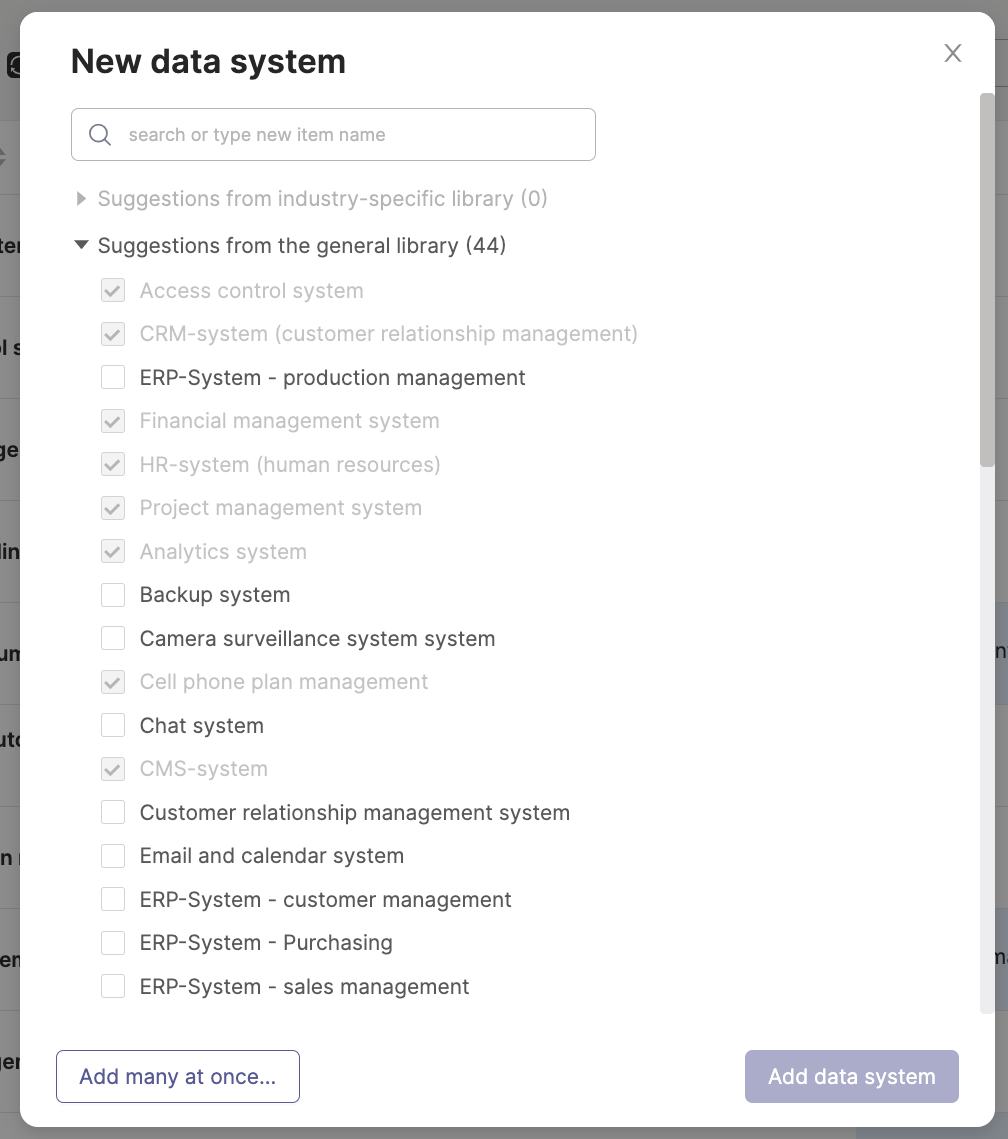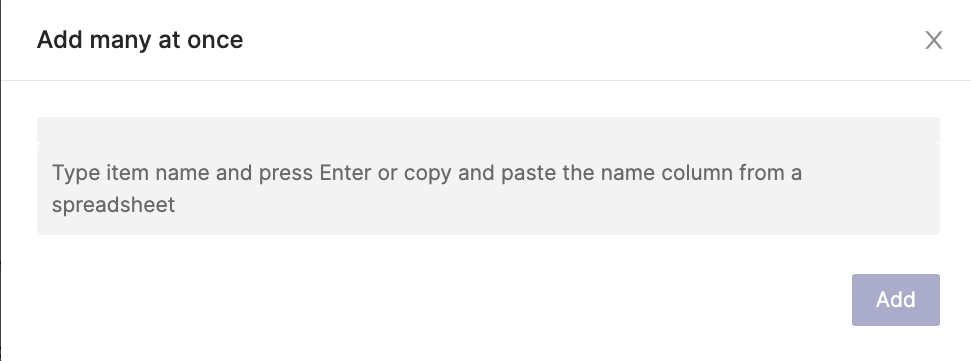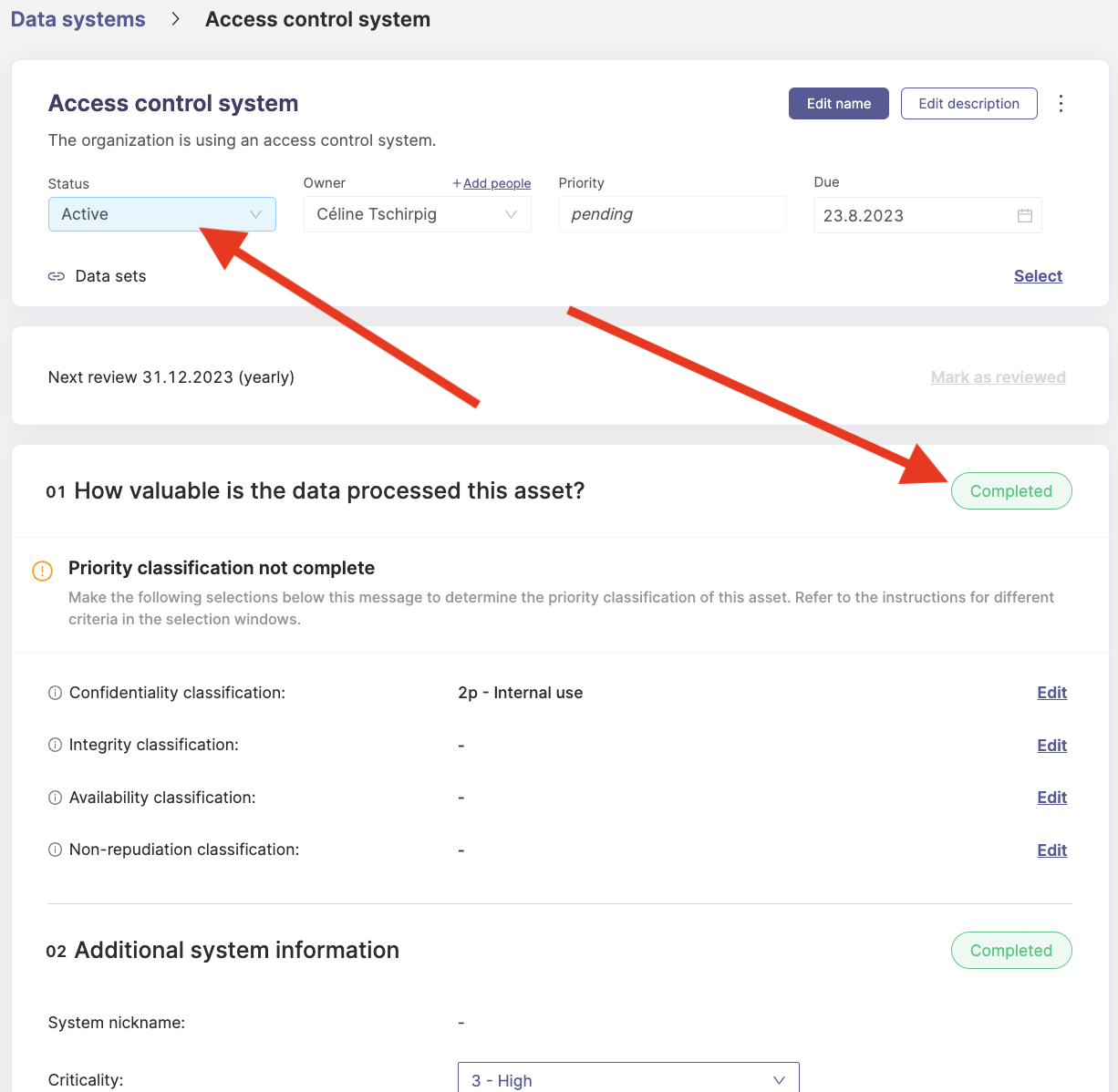Cyberday ger dig inte bara möjlighet att t.ex. skapa policyer, du kan också hålla alla dina dokumentationsobjekt i en översikt på ett och samma ställe. För att skapa eller komma åt din dokumentationstabell, öppna fliken Dokumentation från menyn till vänster i din organisations kontrollpanel.
Vad används den till?
I dokumentationsdelen av Cyberday kan du effektivt dokumentera viktiga delar av din databehandlingsmiljö på ett systematiskt sätt. Det kan t.ex. handla om tillgångar (datasystem, datalager, anläggningar, fysisk utrustning etc.), intressenter (systemleverantörer, personuppgiftsbiträden, andra intressenter etc.) eller register (risker, incidenter, kontinuitetsplaner etc.). Du kan börja med att lägga till dokumentationstabellerna och fylla i fler detaljer via vår mall för varje dokumentationspunkt senare.
Typer av dokumentation
När du går till sidan med dokumentationslistan hittar du ett urval/filter av dokumentationstyp. När du lägger till dokumentation ska du i allmänhet se till att rätt dokumentationstyp har valts. Dokumentationstypen har en inverkan på mallen för dokumentationsobjektet. Till exempel är typen "register", som ofta ses som den viktigaste typen, i princip att berätta vad organisationen har gjort. Detta är den typ av dokumentation som har ett arbetsflöde. Du kan läsa mer om arbetsflödet längre fram i den här artikeln. I jämförelse är dokumentationen av en risk mer av en ordning av olika stadier av risken, inte ett arbetsflöde.

Arbeta med dokumentationsobjekten
Var hittar jag denna vy? Kontrollpanel -> Dokumentation
Du kommer att se en tabell med olika dokumentationstyper, t.ex. datasystem, revisioner eller cybersäkerhetsrisker. När du öppnar någon av dessa, och även där för varje dokumentationsobjekt i listan, får du ett anslutet dokumentationsobjektkort. Detta är en färdig mall som hjälper dig att fylla i all viktig information för varje dokumentationsobjekt. Vilken information som efterfrågas i dokumentationspostkortet beror på vilken typ av dokumentationspost det gäller. Du kan redigera informationen i kortet när som helst genom att aktivera och inaktivera datafält (med de tre punkterna i det övre högra hörnet). Kom ihåg att alltid ange en ägare för varje dokumentationsobjekt.

Hur man lägger till artiklar i tabellen
Om du vill lägga till en dokumentationspost i listan öppnar du dokumentationstypen, t.ex. Datasystem, och klickar på knappen "Lägg till datasystem" i det övre högra hörnet.

När du har klickat på knappen öppnas ett nytt popup-fönster. Välj det eller de datasystem som du vill lägga till. Obs: När du har valt datasystemet kommer det att skapas i listan, du behöver inte klicka på "Lägg till datasystem" separat igen, du kan stänga fönstret när du är klar.

Om du har många dokumentationsobjekt som du vill lägga till i listan kan du välja alternativet "Lägg till många på en gång..." i det nedre vänstra hörnet av pop-up-fönstret (se skärmdumpen ovan) så öppnas ett nytt fönster:

Klicka på raden där det står "Skriv objektets name (...)" och börja lista dokumentationsobjekten. Du kan också kopiera och klistra in en lista med dokumentationsobjekt (namn) från ett kalkylblad till detta fönster och klicka på "Lägg till".
Fylla i mallen
Var hittar man denna vy: Kontrollpanel -> (Systemhantering ->) Dokumentation -> Datasystem
När ett dokumentationsobjekt har skapats kan du fylla i mer information i dokumentationskortet. Frågorna på kortet beror på typen av dokumentation och i vissa fall aktiverade ramverk, t.ex. GDPR. Kom ihåg att ange en ägare för varje objekt.

Mallen kan innehålla information som grundläggande beskrivning, plats för data och så vidare. Du kan redigera frågorna (datafälten) genom att klicka på de tre punkterna i det övre högra hörnet och välja "Redigera datafält".

Hur man exporterar artiklarna
Du kan enkelt exportera de olika dokumentationslistorna i olika format. Du kan exportera i följande format:
- en smart rapport
- en PDF-rapport (="utskriftsvänlig rapport")
- en Excel-rapport
Öppna helt enkelt den dokumentationslista som du vill exportera och öppna rullgardinsmenyn genom att klicka på de tre punkterna i det övre högra hörnet. Därefter kan du välja mellan en utskrivbar rapport (PDF), en Excel-rapport och en smart rapport.

Att se olika vyer av data
Du kan också ändra vy och filtrera objekten. Om du vill ändra vy klickar du på de tre punkterna i det övre högra hörnet och väljer "Ändra vy". I de två skärmdumparna nedan ser du skillnaden mellan vyerna. I en av vyerna kan du filtrera listan efter olika faktorer, t.ex. ansvarsområden, leverantör, plats och så vidare (se skärmdump "Vy version 2" nedan).


Arbetsflöde
Som nämnts ovan har de olika dokumentationstyperna olika mallar och arbetssätt. Dokumentationstypen "Register" har ett specifikt arbetsflöde, som beskriver dokumentationsobjektets skede. I ett arbetsflöde upptäcker du först ett problem, t.ex. en säkerhetsincident, sedan börjar du arbeta med det genom att beskriva problemet och effekterna, för att sedan fortsätta med behandlingen (skriva ner förbättringarna) tills problemet (i detta fall en säkerhetsincident) är helt löst och kan markeras som avslutat. Med filtret överst i listan kan du lista dokumentationsobjekten efter status i deras arbetsflöde.

Status automatisering
Våra dokumentationstabeller och mallar har en statusautomatiseringsfunktion. Det innebär att om du t.ex. lägger till en ny dokumentationspunkt och inget har lagts till i den ännu, kommer statusen att visas som "ny" i listan.

När du öppnar det nya dokumentationspostkortet och fyller i viss information och markerar vissa delar som slutförda ändras statusen automatiskt till aktiv, du behöver inte ändra det manuellt.

Som du kan se ändras inte bara statusen till aktiv på kortet, utan den aktiva statusen visas nu även i dokumentationslistan:












